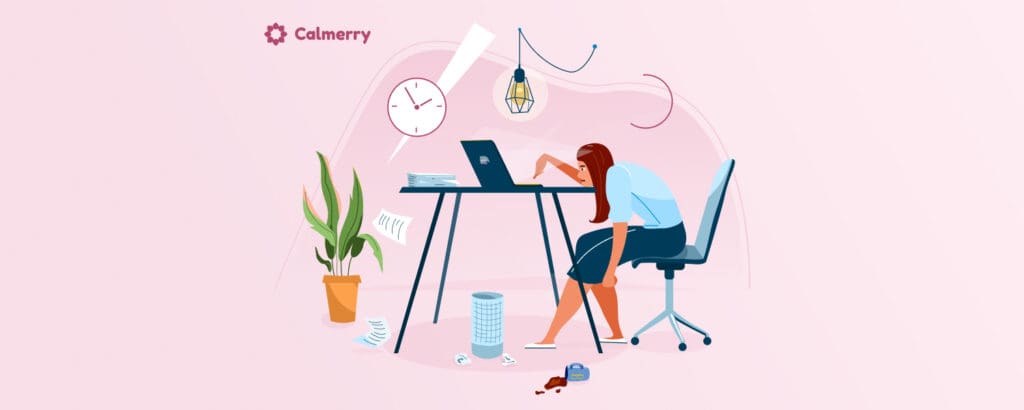Burnout at Work: Signs and Strategies for Identification, Prevention & Support

In this article
Calmerry recently partnered with amazing LYLA – a company that helps teams streamline access to existing benefits and easily connect employees with the support they need.
Together, we hosted a webinar on burnout. It’s still a huge problem affecting people in all kinds of jobs. We wanted to explore it and talk about prevention.
So, we invited the expert – Diamond Marie Thaxton, LMHC, CASAC, Psy.D., a Clinical Psychotherapist at Calmerry – to share her thoughts on how to spot burnout, prevent it, and help those who are going through it at work.
Diamond’s insights are must-reads for everyone!
What is burnout?
The World Health Organization classifies burnout as a significant occupational condition.(1) It’s not merely a state of exhaustion but a deep-seated depletion that undermines one’s professional and personal capabilities.
Diamond explains, “Burnout is a state of emotional, physical, and mental exhaustion caused by prolonged stress.”
Signs of work burnout
The main components of burnout include:
- Exhaustion: “And we’re not talking about just typical. It’s the morning. It’s spring forward. But you are physically exhausted that you’re drinking the water, you’re getting the sleep, you’re getting the sunlight, you’re taking your vitamin D, but for some reason, you’re still just exhausted,” Diamond says.
- Cynicism or detachment: “So that’s when we start to recognize low empathy. You’re kind of just like, ‘Okay, here we go again.’ Everyone has the same issue, and you just start to really lose that empathy and enthusiasm, and things just start to seem more grim and have a cloud. And then even when you’re at work, and the things you actually did enjoy about the job are starting to fade away, too, you’re annoyed about those things as well.”
- Feelings of ineffectiveness: “Where you’re feeling like, ‘What I’m doing is pointless. This doesn’t make any sense. I don’t feel like I am contributing. I don’t feel like I am appreciated.’ And this is a constant feeling, not a fleeting feeling. But even when people are telling you, giving you compliments, like, ‘Whoa, amazing report, amazing customer service!’, and you’re still kind of like, ‘Oh, it wasn’t.’”
- Lack of accomplishment: “Again, just feeling stagnant, not happy for the small wins, not happy for the small interactions you used to enjoy.”
Of course, these things can be fleeting because we’re humans, and we’re allowed to experience a wide range of emotions. Every day is not going to be our best day. So the question you have to ask yourself – is this happening every single time?
– Diamond Marie Thaxton, LMHC, CASAC, Psy.D., a Clinical Psychotherapist
Mental burnout
Mental burnout can lead to a range of symptoms, including:
- Dreading work: “If you feel like you’re at that point that you need to quiet-quit, then clearly you are experiencing burnout.”
- Lack of interest or motivation
- Uncontrollable procrastination
- Decreased satisfaction
Physical burnout
Physical burnout can take a toll on your body, causing:
- Insomnia: “Even when you’re at work, and the things that you actually did enjoy about the job are starting to fade away, too, you’re annoyed about those things as well.”
- Chronic fatigue: “We’re not talking about just typical. It’s the morning. It’s spring forward. I lost an hour of sleep. But you are physically exhausted. You’re drinking the water, you’re getting the sleep, you’re getting the sunlight, you’re taking your vitamin D, but for some reason, you’re still just exhausted.”
- Increased illness
- Headaches, muscle aches, etc.
Emotional burnout
Emotional burnout can affect your relationships and overall well-being, leading to:
- Compassion fatigue
- Increased cynicism
- Apathy
- Mood swings
Effects of burnout
Burnout can have significant effects on mental and physical health and professional impact.
Mental health effects:
- Anxiety
- Depression
- Substance use disorder
Physical health effects:
- Chronic fatigue
- Headaches
- Gastrointestinal issues
Professional impact:
- Increased absenteeism
- Reduced productivity
- Poor job satisfaction
As to the mental health effects, Diamond explains, “If you’re constantly burnout, your body goes into fight or flight and thinks, ‘If I have anxiety, I’ll always be ready to go. I’ll always be on.’ Depression comes because, ‘I might as well stay in this state of a low mood, because if I’m in a high mood, something will always happen, and I can’t really manage it.’”
Statistics on burnout
Diamond shared some alarming statistics on burnout:
- 72% of employees said burnout impacted their performance
- 8 in 10 health workers experienced workplace violence
- 76% reported burnout
- 66% of nurses considered resigning
You’re not alone. It’s not just you. Let’s not get into impostor syndrome where you feel like you’re just the one that can’t tough it out. You’re the one that just can’t do all the work. No, everyone is struggling because the workload is getting to near-impossible limits. Okay? We’re all humans.
– Diamond Marie Thaxton, LMHC, CASAC, Psy.D., a Clinical Psychotherapist
Individual strategies for addressing burnout
“But the biggest thing with burnout is asking yourself, am I experiencing burnout?
The second step, talk to someone, weigh the temperature, see who else is struggling. Take an assessment of your work environment:
- What’s really triggering?
- What’s bothering you?
- What’s going on?
Talk to someone, a professional, like a therapist, a counselor, HR, someone where you can begin to get the conversation around. What are my next steps as an individual to address my burnout?” shares Diamond, along with the strategies below.
Stress management techniques
Diamond recommends exercise, mindfulness, and relaxation techniques to manage stress.
“Exercise is a big one. It can come in so many forms, even if you’re at your chair. Deep breathing, yoga poses, hands up, stretching, just little things like that are still considered exercises.
Mindfulness, similar to meditation. Just being mindful, taking the deep breath, looking around, noticing the color of the walls, noticing, feeling the shirt on you, just giving yourself just a moment of silence to ground yourself.
And these little pocket moments of silence allow you to be able to destress just a little bit. Might not turn the dial all the way down if you’re in an intense work environment. But just sometimes that grounding is very important.
What I really appreciate about the grounding techniques with working with the military, that’s part of their training, is the mindfulness of when there is intense things going on. How do you center yourself in the moment so that way you’re able to be effective in what it is that you need to do.
– Diamond Marie Thaxton, LMHC, CASAC, Psy.D., a Clinical Psychotherapist
And this strategy can also be implemented in other workplaces.”
Prioritizing yourself and setting boundaries
Prioritizing yourself and your needs is very important. But it can be challenging.
Diamond suggests starting small by facing your needs, practicing saying no to little things, and building up to bigger boundaries: “What’s in your control? Are you saying yes to everything because you yourself, deep inside, are a people-pleaser? Are you just the type of person who just jumps into things without thinking?
If you’re a people-pleaser, that’s an identity thing because you really have to figure out why you’re people-pleasing. What is an unmet need that you have that you’re trying to fulfill by being a people-pleaser? So that’s a good start for you.
It could come for many reasons why that skill developed in you. It developed because you were trying to adapt to your environment at some point, but now you have to kind of rewire your brain to say, ‘Okay, this skill is no longer effective. I’m in a new environment where I need different survival skills.’
So that’s why I would say my first suggestion for beginning to set boundaries is to figure out why you’re doing this. What is that unmet need? And then practice saying no.
Practice saying no with little things. For instance, if your burger didn’t come out right, go back and say, ‘Hey, this wasn’t correct.’”
Little things of speaking up for yourself and saying no will allow you to be able to build up to the big no.
– Diamond Marie Thaxton, LMHC, CASAC, Psy.D., a Clinical Psychotherapist
Establishing work-life balance and taking breaks
Diamond acknowledges that work-life balance can be difficult to achieve, but she encourages doing what’s in your control: “If you can take that vacation, if you can take that day off, if you can say no to that project, do it.”
She also stresses the importance of taking breaks, even if it’s just five minutes to close your computer and eat: “Even though you know work is going to be intense. It might be grueling, but saying to yourself, ‘I got this. It’s going to work out!’ Having that growth mindset really allows you to have some cognitive flexibility to adapt to things.”
How companies can help their employees cope with burnout
“Best professional advice I’ve ever had: customers and clients don’t come first. Take care of the team first, and the team will take care of the customers,” – says Diamond.
“And believe it or not, this is what upper management’s job is to do – is to create supportive work environments. We like to say that possibly people don’t know what they don’t know. So if they don’t know that the environment is not conducive to your success, then things are going to go as business as usual.”
1. Overcoming stigma
It’s critical to encourage openness and normalize discussions about mental health and burnout in the workplace.
Diamond comments, “If we all share with each other, like, ‘Hey, this is what’s going on,’ everyone has to speak up for there to be change. So if we break that stigma, slowly but surely, it just allows the camaraderie, and it does allow for change.”
2. Creating supportive environments
Through policies that reduce workload, provide adequate staffing, and promote work-life balance.
Also, empower employees by encouraging staff input in decision-making and offering flexibility in scheduling.
“Ideas don’t have labels, right? They don’t have labels as far as how much weight they carry based on the person that it’s coming out of. And those are the type of most successful environments that we see that are collaborative, where everyone has a voice, everyone is on the same team.”
3. Partner with mental health startups
Despite the growing awareness of mental health in the workplace, the level of support provided by companies often falls short.
Employees may not have access to a trusted professional to whom they can turn for help with deeper issues like burnout, stress, trauma, depression, or grief.
Partnering with mental health startups can be a valuable way to bridge this gap. And this is our mission here at Calmerry.
We have over 1,000 licensed therapists, counselors, and coaches to support your employees.
“For me, what I enjoy about Calmerry is text-based therapy. I think it’s amazing. It’s like it’s in your pocket. You can go right to your therapist and say, ‘Hey, right now I am going through it,’ – and you get a response. I just think it’s amazing because, sometimes, it’s hard for us to text loved ones, because they may go into panic mode themselves. They’re giving you advice that might not be what you need at that moment. So I always say text therapy is the big one. And Calmerry is very good at getting a therapist with accessibility for that.”
– Diamond Marie Thaxton, LMHC, CASAC, Psy.D., a Clinical Psychotherapist
By collaborating with Calmerry, companies can:
- Provide employees with confidential access to licensed professionals
- Choose flexible payment models
- Access self-help tools and anonymized reports to track workplace well-being
- Reduce the stigma around seeking help for mental health issues
- Improve employee well-being, productivity, and retention
And by partering with such companies as LYLA, you help your employees to be immediately connected to the benefits you already offer.
online therapy
live video session




